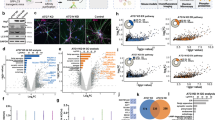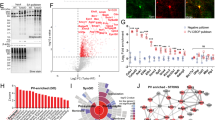Abstract
Mitochondrial dysfunction represents a critical step during the pathogenesis of Parkinson's disease (PD), and increasing evidence suggests abnormal mitochondrial dynamics and quality control as important underlying mechanisms. The VPS35 gene, which encodes a key component of the membrane protein–recycling retromer complex, is the third autosomal-dominant gene associated with PD. However, how VPS35 mutations lead to neurodegeneration remains unclear. Here we demonstrate that PD-associated VPS35 mutations caused mitochondrial fragmentation and cell death in cultured neurons in vitro, in mouse substantia nigra neurons in vivo and in human fibroblasts from an individual with PD who has the VPS35D620N mutation. VPS35-induced mitochondrial deficits and neuronal dysfunction could be prevented by inhibition of mitochondrial fission. VPS35 mutants showed increased interaction with dynamin-like protein (DLP) 1, which enhanced turnover of the mitochondrial DLP1 complexes via the mitochondria-derived vesicle–dependent trafficking of the complexes to lysosomes for degradation. Notably, oxidative stress increased the VPS35-DLP1 interaction, which we also found to be increased in the brains of sporadic PD cases. These results revealed a novel cellular mechanism for the involvement of VPS35 in mitochondrial fission, dysregulation of which is probably involved in the pathogenesis of familial, and possibly sporadic, PD.
This is a preview of subscription content, access via your institution
Access options
Subscribe to this journal
Receive 12 print issues and online access
$209.00 per year
only $17.42 per issue
Buy this article
- Purchase on Springer Link
- Instant access to full article PDF
Prices may be subject to local taxes which are calculated during checkout






Similar content being viewed by others
References
Chan, D.C. Fusion and fission: interlinked processes critical for mitochondrial health. Annu. Rev. Genet. 46, 265–287 (2012).
Yan, M.H., Wang, X. & Zhu, X. Mitochondrial defects and oxidative stress in Alzheimer disease and Parkinson disease. Free Radic. Biol. Med. 62, 90–101 (2013).
Burté, F., Carelli, V., Chinnery, P.F. & Yu-Wai-Man,, P. Disturbed mitochondrial dynamics and neurodegenerative disorders. Nat. Rev. Neurol. 11, 11–24 (2015).
Wang, X. et al. Amyloid-β overproduction causes abnormal mitochondrial dynamics via differential modulation of mitochondrial fission/fusion proteins. Proc. Natl. Acad. Sci. USA 105, 19318–19323 (2008).
Chen, Y. & Dorn, G.W. PINK1-phosphorylated mitofusin 2 is a parkin receptor for culling damaged mitochondria. Science 340, 471–475 (2013).
Clark, I.E. et al. Drosophila Pink1 is required for mitochondrial function and interacts genetically with parkin. Nature 441, 1162–1166 (2006).
Narendra, D., Tanaka, A., Suen, D.F. & Youle, R.J. Parkin is recruited selectively to impaired mitochondria and promotes their autophagy. J. Cell Biol. 183, 795–803 (2008).
Wang, X. et al. LRRK2 regulates mitochondrial dynamics and function through direct interaction with DLP1. Hum. Mol. Genet. 21, 1931–1944 (2012).
Su, Y.C. & Qi, X. Inhibition of excessive mitochondrial fission reduced aberrant autophagy and neuronal damage caused by the LRRK2G2019S mutation. Hum. Mol. Genet. 22, 4545–4561 (2013).
Irrcher, I. et al. Loss of the Parkinson's disease–linked gene DJ-1 perturbs mitochondrial dynamics. Hum. Mol. Genet. 19, 3734–3746 (2010).
Wang, X. et al. Parkinson's disease–associated DJ-1 mutations impair mitochondrial dynamics and cause mitochondrial dysfunction. J. Neurochem. 121, 830–839 (2012).
Lim, K.L., Ng, X.H., Grace, L.G. & Yao, T.P. Mitochondrial dynamics and Parkinson's disease: focus on parkin. Antioxid. Redox Signal. 16, 935–949 (2012).
Vives-Bauza, C. et al. Control of mitochondrial integrity in Parkinson's disease. Prog. Brain Res. 183, 99–113 (2010).
Sharma, M. et al. A multicenter clinico-genetic analysis of the VPS35 gene in Parkinson disease indicates reduced penetrance for disease-associated variants. J. Med. Genet. 49, 721–726 (2012).
Vilariño-Güell, C. et al. VPS35 mutations in Parkinson disease. Am. J. Hum. Genet. 89, 162–167 (2011).
Zimprich, A. et al. A mutation in VPS35, encoding a subunit of the retromer complex, causes late-onset Parkinson disease. Am. J. Hum. Genet. 89, 168–175 (2011).
Kumar, K.R. et al. Frequency of the D620N mutation in VPS35 in Parkinson disease. Arch. Neurol. 69, 1360–1364 (2012).
Lesage, S. et al. Identification of VPS35 mutations replicated in French families with Parkinson disease. Neurology 78, 1449–1450 (2012).
Bonifacino, J.S. & Hurley, J.H. Retromer. Curr. Opin. Cell Biol. 20, 427–436 (2008).
Burd, C. & Cullen, P.J. Retromer: a master conductor of endosome sorting. Cold Spring Harb. Perspect. Biol. 6, a016774 (2014).
Braschi, E. et al. Vps35 mediates vesicle transport between the mitochondria and peroxisomes. Curr. Biol. 20, 1310–1315 (2010).
Soubannier, V. et al. A vesicular transport pathway shuttles cargo from mitochondria to lysosomes. Curr. Biol. 22, 135–141 (2012).
Sugiura, A., McLelland, G.L., Fon, E.A. & McBride, H.M. A new pathway for mitochondrial quality control: mitochondrial-derived vesicles. EMBO J. 33, 2142–2156 (2014).
Yoon, Y., Pitts, K.R., Dahan, S. & McNiven, M.A. A novel dynamin-like protein associates with cytoplasmic vesicles and tubules of the endoplasmic reticulum in mammalian cells. J. Cell Biol. 140, 779–793 (1998).
Seaman, M.N. The retromer complex—endosomal protein recycling and beyond. J. Cell Sci. 125, 4693–4702 (2012).
Cassidy-Stone, A. et al. Chemical inhibition of the mitochondrial division dynamin reveals its role in Bax/Bak-dependent mitochondrial outer membrane permeabilization. Dev. Cell 14, 193–204 (2008).
Roy Chowdhury, S.K. et al. Impaired adenosine monophosphate–activated protein kinase signaling in dorsal root ganglia neurons is linked to mitochondrial dysfunction and peripheral neuropathy in diabetes. Brain 135, 1751–1766 (2012).
Brand, M.D. & Nicholls, D.G. Assessing mitochondrial dysfunction in cells. Biochem. J. 435, 297–312 (2011).
Merrill, R.A. et al. Mechanism of neuroprotective mitochondrial remodeling by PKA/AKAP1. PLoS Biol. 9, e1000612 (2011).
Zhu, P.P. et al. Intra- and intermolecular domain interactions of the C-terminal GTPase effector domain of the multimeric dynamin-like GTPase Drp1. J. Biol. Chem. 279, 35967–35974 (2004).
Zhao, J. et al. Human MIEF1 recruits Drp1 to mitochondrial outer membranes and promotes mitochondrial fusion rather than fission. EMBO J. 30, 2762–2778 (2011).
Liu, T. et al. The mitochondrial elongation factors MIEF1 and MIEF2 exert partially distinct functions in mitochondrial dynamics. Exp. Cell Res. 319, 2893–2904 (2013).
Lucin, K.M. et al. Microglial beclin 1 regulates retromer trafficking and phagocytosis, and is impaired in Alzheimer's disease. Neuron 79, 873–886 (2013).
McLelland, G.L., Soubannier, V., Chen, C.X., McBride, H.M. & Fon, E.A. Parkin and PINK1 function in a vesicular trafficking pathway regulating mitochondrial quality control. EMBO J. 33, 282–295 (2014).
Soubannier, V., Rippstein, P., Kaufman, B.A., Shoubridge, E.A. & McBride, H.M. Reconstitution of mitochondria-derived vesicle formation demonstrates selective enrichment of oxidized cargo. PLoS ONE 7, e52830 (2012).
Neuspiel, M. et al. Cargo-selected transport from the mitochondria to peroxisomes is mediated by vesicular carriers. Curr. Biol. 18, 102–108 (2008).
Chan, D.C. Mitochondrial fusion and fission in mammals. Annu. Rev. Cell Dev. Biol. 22, 79–99 (2006).
Lackner, L.L. & Nunnari, J.M. The molecular mechanism and cellular functions of mitochondrial division. Biochim. Biophys. Acta 1792, 1138–1144 (2009).
Zunino, R., Braschi, E., Xu, L. & McBride, H.M. Translocation of SenP5 from the nucleoli to the mitochondria modulates DRP1-dependent fission during mitosis. J. Biol. Chem. 284, 17783–17795 (2009).
Tsika, E. et al. Parkinson's disease–linked mutations in VPS35 induce dopaminergic neurodegeneration. Hum. Mol. Genet. 23, 4621–4638 (2014).
McGough, I.J. et al. Retromer binding to FAM21 and the WASH complex is perturbed by the Parkinson disease–linked VPS35D620N mutation. Curr. Biol. 24, 1670–1676 (2014).
Follett, J. et al. The Vps35D620N mutation linked to Parkinson's disease disrupts the cargo sorting function of retromer. Traffic 15, 230–244 (2014).
Zavodszky, E. et al. Mutation in VPS35 associated with Parkinson's disease impairs WASH complex association and inhibits autophagy. Nat. Commun. 5, 3828 (2014).
Wang, X. et al. Impaired balance of mitochondrial fission and fusion in Alzheimer's disease. J. Neurosci. 29, 9090–9103 (2009).
Wang, X., Su, B., Fujioka, H. & Zhu, X. Dynamin-like protein 1 reduction underlies mitochondrial morphology and distribution abnormalities in fibroblasts from sporadic Alzheimer's disease patients. Am. J. Pathol. 173, 470–482 (2008).
Fujioka, H., Tandler, B., Consolo, M.C. & Karnik, P. Division of mitochondria in cultured human fibroblasts. Microsc. Res. Tech. 76, 1213–1216 (2013).
Fujioka, H. et al. Decreased cytochrome c oxidase subunit VIIa in aged rat heart mitochondria: immunocytochemistry. Anat. Rec. (Hoboken) 294, 1825–1833 (2011).
Hanaichi, T. et al. A stable lead by modification of Sato's method. J. Electron Microsc. (Tokyo) 35, 304–306 (1986).
Acknowledgements
This work is partly supported by the US National Institutes of Health (NIH) (grant no. NS071184 (X.Z.), NS083498 (X.Z.) and NS085747 (X.W.)); the Clinical and Translational Science Collaborative of Cleveland; the National Center for Advancing Translational Sciences component of the NIH and the NIH Roadmap for Medical Research (grant no. UL1TR000439; pilot award to X.Z.); the Chinese Overseas, Hong Kong and Macao Scholars Collaborated Research Fund (grant no. 81228007; X.Z.); the Shanghai Orientalist program (X.Z.), the Dr. Robert M. Kohrman Memorial Fund (X.Z.); the National Natural Science Fund of China (grant no. 81071024, 81171202, 30870879, 81228007 and 81471287; all to J.L.); the Wellcome Trust (grant no. 089928 and 085743; both to P.J.C.) and the Medical Research Council (grant no. MR/K018299/1; P.J.C.). We thank I. Kelmanson (Evrogen) for the mito-TagBFP construct and Y. Yoon (University of Rochester) for the DLP1WT and DLP1K38A constructs. Some Parkinson's disease tissue samples were obtained from the Harvard Brain Tissue Resource Center, which is supported in part by the Public Health Service contract (HHS-NIH-NIDA (MH)-13-265), and from the NIH Neurobiobank at the University of Maryland.
Author information
Authors and Affiliations
Contributions
X.Z. and X.W. conceived and directed the project, interpreted the results and wrote the manuscript. W.W. and X.W. designed and carried out experiments, analyzed results and generated figures. H.F. helped with electron microscopy (EM) and the immuno-EM study; C.H. helped with bioenergetics measurements; A.L.W., M.A.C. and P.J.C. contributed fibroblasts from the individual with PD who has the VPS35D620N mutation and provided feedback on the manuscript; and J.L. contributed to the conception of the project, design of the experiments and the interpretation of results, and provided feedback on the manuscript.
Corresponding authors
Ethics declarations
Competing interests
The authors declare no competing financial interests.
Supplementary information
Supplementary Text and Figures
Supplementary Figures 1–15 (PDF 5040 kb)
Rights and permissions
About this article
Cite this article
Wang, W., Wang, X., Fujioka, H. et al. Parkinson's disease–associated mutant VPS35 causes mitochondrial dysfunction by recycling DLP1 complexes. Nat Med 22, 54–63 (2016). https://doi.org/10.1038/nm.3983
Received:
Accepted:
Published:
Issue Date:
DOI: https://doi.org/10.1038/nm.3983
This article is cited by
-
Mitochondrial dysfunction in Parkinson’s disease – a key disease hallmark with therapeutic potential
Molecular Neurodegeneration (2023)
-
VPS35 and α-Synuclein fail to interact to modulate neurodegeneration in rodent models of Parkinson’s disease
Molecular Neurodegeneration (2023)
-
Parkinson’s Disease, Parkinsonisms, and Mitochondria: the Role of Nuclear and Mitochondrial DNA
Current Neurology and Neuroscience Reports (2023)
-
Targeting Mitochondria as a Therapeutic Approach for Parkinson’s Disease
Cellular and Molecular Neurobiology (2023)
-
Limiting mitochondrial plasticity by targeting DRP1 induces metabolic reprogramming and reduces breast cancer brain metastases
Nature Cancer (2023)



